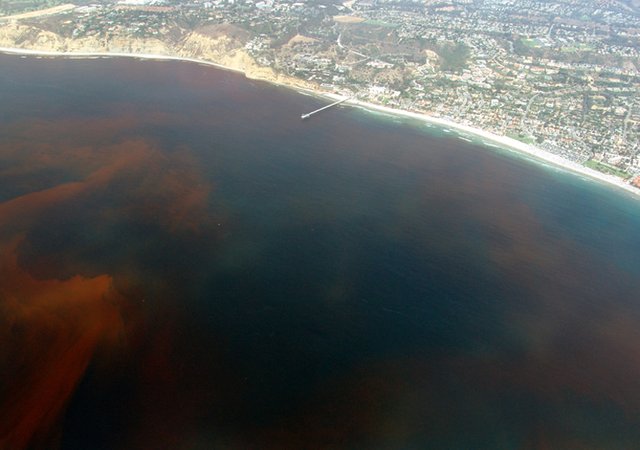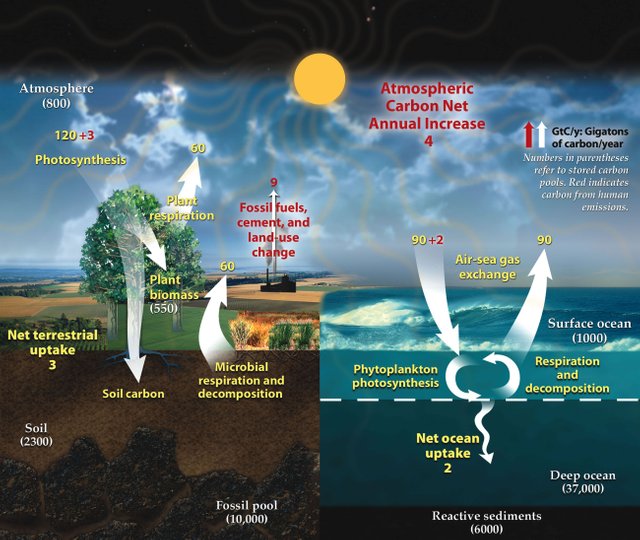(I have not forgotten Project Orion - just had a lot of trouble finding the information I need to continue. But @professorbromide has solved that for me. So next time, the Orion series will continue)

The past leaves its mark on the present.
Whether it's a scar on human skin, a crater in the desert, or the light of a distant star, the past is always reaching out to communicate with the present through lingering echoes
Some events, like asteroids for instance, can leave marks obvious to the layman. But in the depths of the ocean, under the muck of the seabed, the past has left more ephemeral, but no less edifying, clues.
But before we discuss these new clues, and what they portend for humanity's future, you need a quick crash course on the major topics involved.
The Cretaceuous Era And Oceanic Anoxic Events
Anoxic means lacking in oxygen.
An "Oceanic Anoxic Event" ("OAE") is a period during which some large part of the ocean becomes depleted of oxygen. You can see that sort of thing happening on a smaller scale nowadays. These are not true anoxic events, but rather hypoxic events, where oxygen levels are not zero but do fall under 2%.
The Cretaceuous period was a long time span between 145-66 million years ago. By the start of the Cretaceuous period, the super continent Pangea had already broken up entirely, and over the course of the period, some of the most impressive dinosaurs thrived - e.g. T-Rex and Triceratops.
In the beginning of the Cretaceuous period, it was still sort of chilly. But as millions of years passed, probably due to a ton of volcanoes spewing greenhouse gases into the air, the planet warmed a lot. As the planet warmed, at least two OAEs occurred, wherein large swaths of the oceans become anoxic. Sometimes this resulted in the widespread growth of algea which produced poisonous sulphur based compounds and made the air less breathable.

How An Oxic Ocean Becomes Anoxic
Right now, the ocean is mostly "oxic", meaning it is infused with oxygen. As a result of this oxic state, and the increasing heat, life in the top most layer of the ocean, the "euphotic zone", is thriving. This life consumes carbon from the air, and then, when it dies, the carbon sinks to the bottom of the ocean, where it is reprocessed into carbon dioxide.
The conversion of the carbon from that dead material into CO2 consumes oxygen from the water. This can create a vicious cycle, wherein life grows on the surface of the water in larger and larger quantites, dies, sinks to the bottom, and then consumes more oxygen as its converted to CO2. This "should lead to a progressive expansion in anoxic portions of the ocean."
We know that this has happened before, during the Cretaceuous period, and that the oxic ocean transitioned into an anoxic state. But we don't know how long that transition took.
New research clarifies the timetables involved
Research presented in Science Advances attempts to clarify how long the transition from oxic to largely anoxic oceans actually took. Figuring that out took a lot of digging and a bunch of chemistry.

First, they needed to get access to sediment that dated back to the Cretaceuous OAE. They chose a deposit of black shale from a location called the Demerara Rise, over the northern coast of South America. They drilled down to a depth that aligned with one of the cretaceuous OAEs and then tested the material.
What they were looking for were trace amounts of an element called Thallium. Like many elements, thallium comes in different isotopes, each with different properties.
Suffice it to say, certain types of thallium isotopes are indicative of more oceanic oxygen, and certain types are indicative of less oceanic oxygen.
For more info, for the more chemically inclined, I encourage you dive into the nitty gritty of the paper. But for the rest of us, that's all you need to know to understand the findings.
Results
The researchers measured the amount of different isotopes of thallium at different depths in the shale and what they found was a clear pattern of progressive change in the type of thallium isotope present therein.
As the scientists tested samples closer to known OAE events, the amount of thallium isotope associated with low oxygen ocean water increased.
This also allowed the researchers to infer a concurrent loss of oceanic oxygen during the same time period. Furthermore, this finding matched shale deposit measurements from a distant seabed located in Europe as well.
By focusing in on thallium isotope measurements, the researchers were also able to come up with a far more specific time table for how long that transition from oxic to anoxic took: 32,000-54,000 years from the start of oxygen loss to peak OAE.
Geologically speaking, this is almost no time at all - the geologic equivalent of the blink of an eye. It is also far less than the previous estimate of nearly 700,000 years.

Takeaway
What does this all mean?
Some of the most notorious OAE events in Earth's history were precursed by a progressive loss of ocean oxygen, leading to an ocean that was substantially anoxic and detrimental to global life. The transition from oxic to anoxic happened in as little as 32,000 years, which is a hot second in geologic time scales.
Meanwhile, in the modern day, smaller hypoxic events are already happening with increasingly frequency and may be indicative of the beginning of a renewed process of widespread anoxia in the oceans. As the researchers aptly put it:
Without positive human intervention, ancient OAE studies are destined to become uncomfortably applicable [to modern oceans] in the not-so-distant future.
Support #STEEMSTEM - curating quality STEM content on steemit
Quotations are excerpted from cited research paper.
Information sources
Constraining the rate of oceanic deoxygenation leading up to a Cretaceous Oceanic Anoxic Event (OAE-2: ~94 Ma) BY CHADLIN M. OSTRANDER, JEREMY D. OWENS, SUNE G. NIELSEN SCIENCE ADVANCES09 AUG 2017 : E1701020
Carbon Cycle NOAA
Hypoxia Watch NOAA
Wikipedia On The Cretaceuous Era
Photo Sources
[1]Alejandro Díaz self work, public domain, via wikimedia commons
[2]Biswarup Ganguly, CC BY 3.0 , via Wikimedia Commons
[3]By Diagram adapted from U.S. DOE, Biological and Environmental Research Information System. [Public domain], via Wikimedia Commons
[4]Der_Messer self work, CC-BY-SA-3.0, via Wikimedia Commons
[5]By United States Fish and Wildlife Service. [Public domain], via Wikimedia Commons
Upvoted and Resteemed by xx-votesplus, the dropAhead curation team!
Do you want more earnings?
By doing things above you will give us more STEEM POWER (SP) to give you more earnings.
Keep up the good work!
Most recent post: It is official, WE are witnesses!
Downvoting a post can decrease pending rewards and make it less visible. Common reasons:
Submit
This post received a 2.3% upvote from @randowhale thanks to @dber! For more information, click here!
Downvoting a post can decrease pending rewards and make it less visible. Common reasons:
Submit
Congratulations! This post has been upvoted from the communal account, @minnowsupport, by DBER from the Minnow Support Project. It's a witness project run by aggroed, ausbitbank, teamsteem, theprophet0, someguy123, neoxian, followbtcnews/crimsonclad, and netuoso. The goal is to help Steemit grow by supporting Minnows and creating a social network. Please find us in the Peace, Abundance, and Liberty Network (PALnet) Discord Channel. It's a completely public and open space to all members of the Steemit community who voluntarily choose to be there.
Downvoting a post can decrease pending rewards and make it less visible. Common reasons:
Submit
@dber got you a $1.63 @minnowbooster upgoat, nice! (Image: pixabay.com)
Want a boost? Click here to read more!
Downvoting a post can decrease pending rewards and make it less visible. Common reasons:
Submit